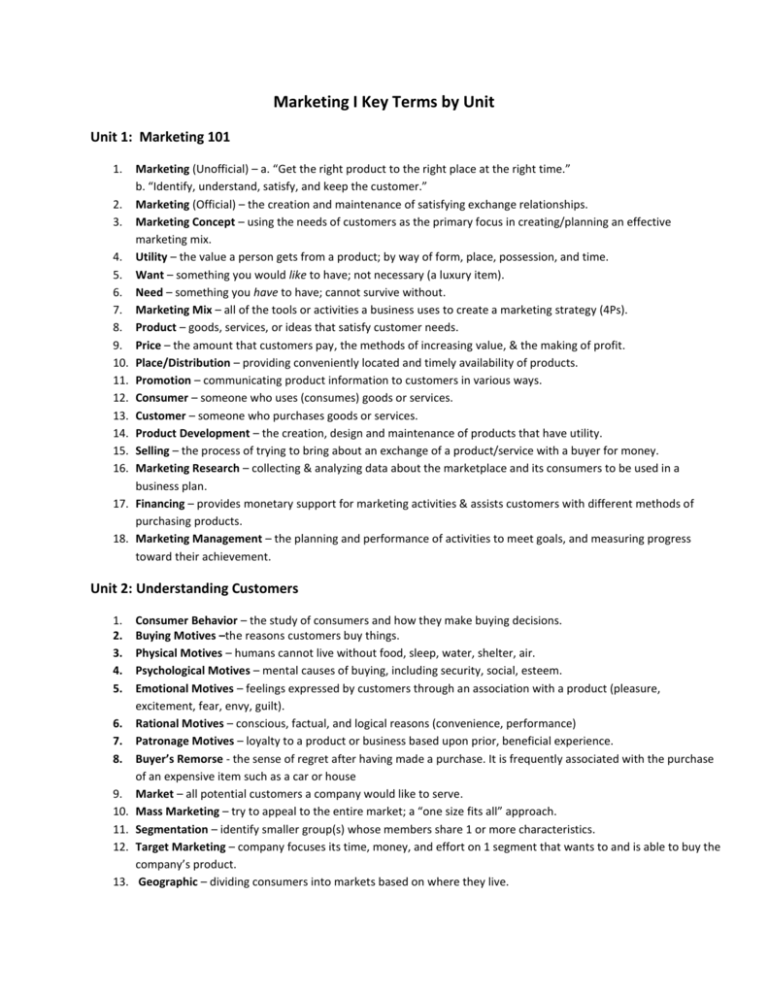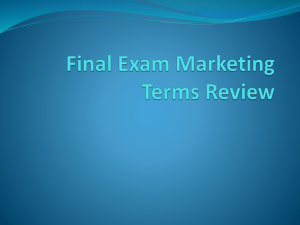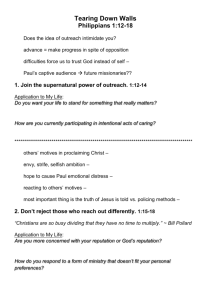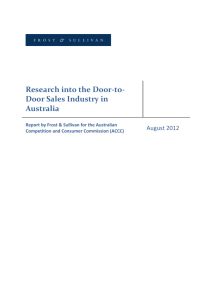File
advertisement

Marketing I Key Terms by Unit Unit 1: Marketing 101 1. 2. 3. 4. 5. 6. 7. 8. 9. 10. 11. 12. 13. 14. 15. 16. 17. 18. Marketing (Unofficial) – a. “Get the right product to the right place at the right time.” b. “Identify, understand, satisfy, and keep the customer.” Marketing (Official) – the creation and maintenance of satisfying exchange relationships. Marketing Concept – using the needs of customers as the primary focus in creating/planning an effective marketing mix. Utility – the value a person gets from a product; by way of form, place, possession, and time. Want – something you would like to have; not necessary (a luxury item). Need – something you have to have; cannot survive without. Marketing Mix – all of the tools or activities a business uses to create a marketing strategy (4Ps). Product – goods, services, or ideas that satisfy customer needs. Price – the amount that customers pay, the methods of increasing value, & the making of profit. Place/Distribution – providing conveniently located and timely availability of products. Promotion – communicating product information to customers in various ways. Consumer – someone who uses (consumes) goods or services. Customer – someone who purchases goods or services. Product Development – the creation, design and maintenance of products that have utility. Selling – the process of trying to bring about an exchange of a product/service with a buyer for money. Marketing Research – collecting & analyzing data about the marketplace and its consumers to be used in a business plan. Financing – provides monetary support for marketing activities & assists customers with different methods of purchasing products. Marketing Management – the planning and performance of activities to meet goals, and measuring progress toward their achievement. Unit 2: Understanding Customers 1. 2. 3. 4. 5. 6. 7. 8. 9. 10. 11. 12. 13. Consumer Behavior – the study of consumers and how they make buying decisions. Buying Motives –the reasons customers buy things. Physical Motives – humans cannot live without food, sleep, water, shelter, air. Psychological Motives – mental causes of buying, including security, social, esteem. Emotional Motives – feelings expressed by customers through an association with a product (pleasure, excitement, fear, envy, guilt). Rational Motives – conscious, factual, and logical reasons (convenience, performance) Patronage Motives – loyalty to a product or business based upon prior, beneficial experience. Buyer’s Remorse - the sense of regret after having made a purchase. It is frequently associated with the purchase of an expensive item such as a car or house Market – all potential customers a company would like to serve. Mass Marketing – try to appeal to the entire market; a “one size fits all” approach. Segmentation – identify smaller group(s) whose members share 1 or more characteristics. Target Marketing – company focuses its time, money, and effort on 1 segment that wants to and is able to buy the company’s product. Geographic – dividing consumers into markets based on where they live. 14. 15. 16. 17. 18. 19. Demographics – measurable characteristics (age, gender, race, income, and educational level). Psychographics – people’s social class, lifestyle and personality (Baby Boomer, active, introvert). Product Usage – how and how often consumers use a product. Benefits Derived – the value or satisfaction consumers receive from the product or service. Market Potential – the total revenue that can be obtained from a market segment. Market Share – the segment (%) of the total market that each company or product controls in relation to its competitors. 20. Marketing Intelligence – the process of gathering competitive marketing information. Unit 3: Product Development 1. 2. 3. 4. 5. 6. 7. 8. 9. 10. 11. 12. 13. 14. 15. 16. 17. 18. 19. Features – physical characteristics of a product used to enhance benefits wanted by consumers. Benefits – the value or usefulness a consumer receives from a product. Final Consumers – those who buy products for their personal use. Business Consumers – those who buy goods to use themselves or to use in the making of other goods/services for the purpose of resale. Convenience Good – inexpensive items which are purchased frequently and with Inminimal effort. Shopping Good – items purchased only after customer has compared price, quality, and style sometimes in more than one store. Unsought Good – items that consumers seldom go out looking for and that may come directly to them (direct mail, door-to-door sales, infomercials, etc). Specialty Good – an item that is extraordinary or very unique; not a regular person’s regular purchase (designer clothes, exotic perfumes, limited-edition cars, artwork). Capital – invested money into property and large machinery with values of over $5000. Operating Equipment – items physically used in the everyday operation of a business (tools, machines, vehicles, etc). Supplies – general purpose consumable items, which are stocked for recurring use (office supplies). Raw Materials – individual goods used in the making of a product (wood & metal for furniture). Component Part – an identifiable part of a larger product (Sony radio found in a Ford truck). Product Life Cycle – a product’s life span from initial development to its eventual removal from the market, which goes through 4 stages: Introduction, Growth, Maturity, and Decline. Product Mix (Assortment) – the combination and make up of all the products a company has to offer. Product Line – a group of similar products with slight variations in the marketing mix to satisfy different consumer needs. Brand – anything (name, mark, logo) that identifies a product or company. Trademark – legal protection, given by the government, of a company’s name or logo. Licensed Brand – a well-known name or symbol established by one company and sold for use by another company to promote its products. Unit 4: Distribution 1. 2. 3. 4. 5. 6. 7. 8. 9. 10. 11. 12. 13. 14. 15. 16. 17. 18. 19. 20. Distribution (Place) – Getting products to the customers; helping customers find and get products. Channel of Distribution – the path a product takes from producer/manufacturer to consumer. Intermediary (Middleman) – anyone who handles a product in between the producer and consumer. Wholesalers – companies that assist with distribution between businesses. Agent – coordinates transactions between businesses that buy and sell products; never owns goods. Retailer – the final business in an indirect channel which sells to consumers. Wholesale Clubs – hybrid between wholesaler and retailer; warehouse set up which sells to consumer members. Bulk – a very large mass, size, or volume. Turnaround – the period of time from when a product first arrives until it is sold. Direct Channel – a path where the producer or manufacturer sells the product directly to the consumer. Indirect Channel –a path where other businesses handle the product in between the producer and the consumer. Reverse Channel – path where product returns to manufacturer from consumer to be recycled. Linked Channel – path where product changes at each level of the distribution chain (grain, flour, bread). Convenience Stores – located very close to their customers, offering a limited line of products that consumers use regularly. Limited-line Stores – offer products from one category of merchandise or closely related items. Box Stores –large box-like, free-standing , single-floor, limited-line store (Best Buy, Home Depot) Department Stores – a large store that sells a wide range of goods in separate categories (Kohls). Superstores – huge department stores with highly diversified merchandise & services. (WalMart). Shopping Centers – group of stores located together and planned as a unit to meet a range of customer needs (Kohls & Hannafords at either end; dry cleaner, pizza shop, hair salon in between). Non-store Retailing – sells directly to the consumer’s home rather than requiring the consumer to travel to a store (direct mail catalogs, websites, door-to-door sales, infomercials). Unit 5: Pricing 1. 2. 3. 4. 5. 6. 7. 8. 9. 10. 11. 12. 13. 14. Price Range – between the minimum a company can charge to cover costs and the maximum a customer is willing to pay. Operating Expenses – sales and administrative costs of doing business. Cost – an amount that has to be paid or given up in order to get something. Production Costs – combined costs of raw materials, machinery, and labor when producing a good. Selling Price – operating expenses + production costs + markup amount Markup – an amount or percentage added to total production costs for desired profit. Net Profit – the difference between the selling price and operating expenses/production costs. Breakeven Point – the quantity of a product that must be sold at a specific price for total revenues to match total costs; this is the beginning point of finally making real profits. Markdown – a reduction from the original selling price. Cost-plus – strategy of taking the production cost and adding an amount or % for profit. Loss Leader – product selling at or below cost to motivate customers to come to store (legal). Predatory – strategy of aggressively pricing low with the purpose of driving out competitors (illegal). Skimming – positioning a product with a high price, compared to others in category, for quicker ROI. Return on Investment (ROI) – a measure of profitability (%) indicating how well a company is using its resources. 15. 16. 17. 18. 19. Penetration – setting an artificially low price to gain market share and then creep it back to normal. Prestige or Premium – pricing set high for unique products with perceived value; luxury items. Bundle – to combine more than 1 product in the same package to add value or move slower sellers. Discount – reduction in the regular selling price of a product for a specific reason. Trade Discount – complimentary reduction in price given to those who are in the related business (Home Depot gives trade discounts to carpenters, plumbers, and electricians). 20. Allowance – an amount of money given back for the performance of an action. Unit 6: Promotions 1. 2. 3. 4. 5. 6. 7. 8. 9. 10. 11. 12. 13. 14. 15. 16. 17. 18. 19. 20. Promotion – any form of communication used to inform, persuade, and remind consumers about a product. Persuade – to influence or try to convince a consumer to do something. Communication Process – the method of transferring a message from a sender to a receiver. Sender – the source or originator of the message in the communication process. Encode – put the ad message/idea into a language & format that intended receivers will understand. Media – the vehicles of mass communication (radio, television, internet, and print). Receiver – the person(s) to whom the encoded message is intended and directed. Decode – interpreting the message and understanding its directive. Interference – any distraction/interruption that causes a receiver to miss the message or misunderstand it (changing the channel, TiVo, left room, noise, etc). Feedback – the receiver’s reaction or response to the sender’s message directive. Directive – instructing the receiver, within the ad message, to do something (buy the product, visit the website, take advantage of the sale this weekend, use the coupon, etc). Interpersonal Communication – delivering messages in person. Mass Communication – involves delivering messages to large audiences through the media. Promotional Mix – combination of advertising, publicity, personal selling, and sales promotion into a strategy for delivering a message to the target market. Advertising – paid form of nonpersonal communication sent through the media by a company. Publicity – nonpaid form of communication sent through the media; usually a news story. Goodwill – the customer’s positive feeling about an organization, product, or service. Public Relations – department within a company, whose job is to plan communication efforts to build goodwill and develop favorable relationships with the public. Personal Selling – face-to-face communication in which a seller attempts to persuade potential customers to make a purchase. Sales Promotions – activities or materials within a place of purchase that offer consumers incentive to act now. Unit 7: Promotional Planning 1. Promotional Plan – multiple activities working together to reinforce a main theme and working toward the company’s goal. 2. Goal (Objective) – desired results to be accomplished within a specific time period. 3. Budget – amount of money put aside by a company for use on certain activities or a plan. 4. Theme – one idea, appeal, or benefit around which all advertising messages in a plan revolve. 5. Circulation – number of magazine or newspapers sold during any time period. 6. Subscribers – number of people who have signed up to receive services (magazines, newspapers, cable tv, etc). 7. Ratings – how many people are listening or watching a particular show, channel, or network. 8. Focus Group – small # of random people asked their opinions or emotional responses about an ad; sometimes comparing ads to see which is best received. 9. Recall Testing –target consumers asked to remember parts of an ad days after viewing. 10. Recognition Testing – showing the ad & then asking pointed questions.







